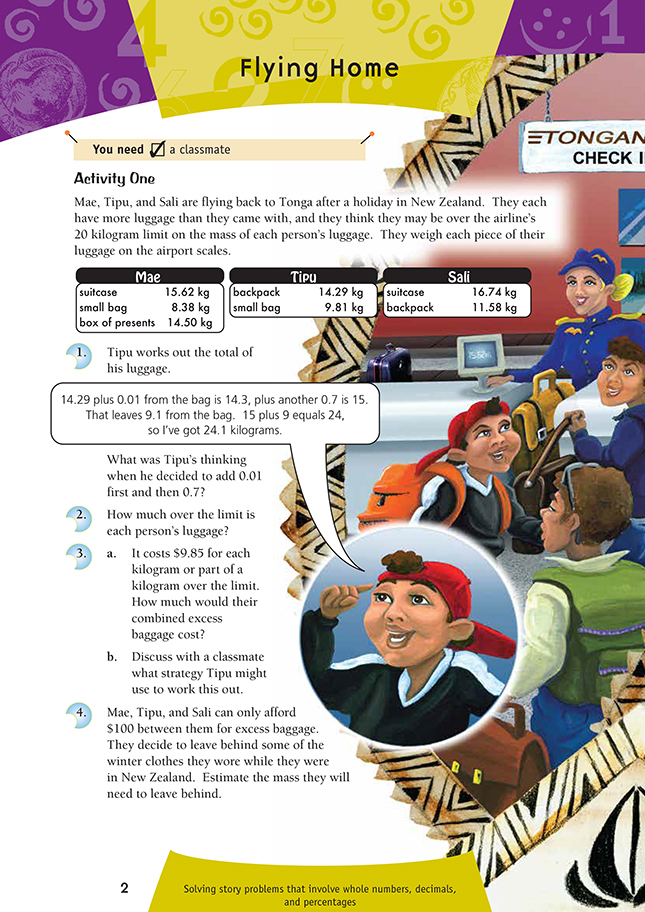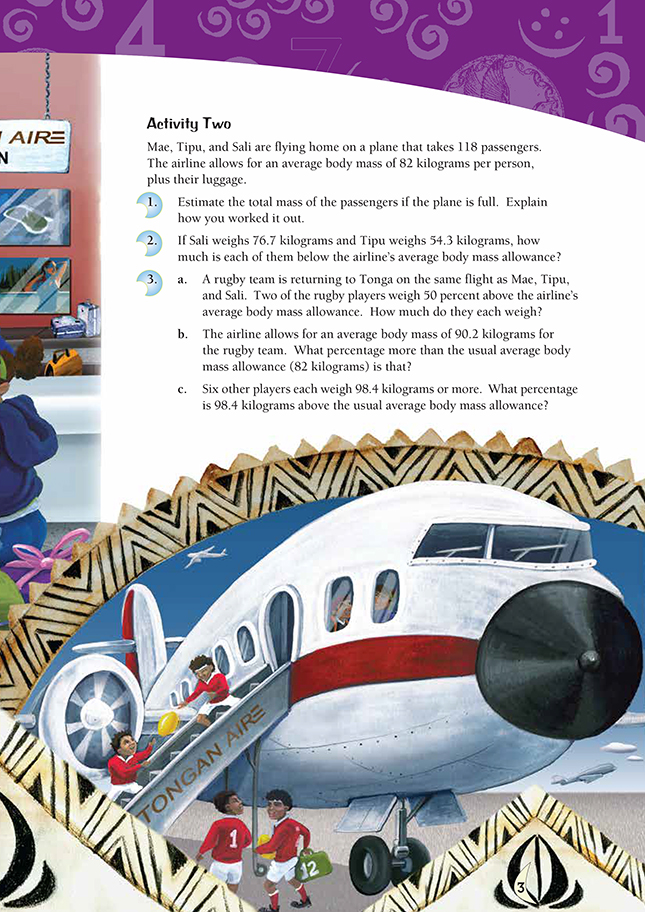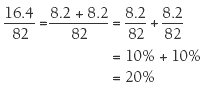This is a level 4 number activity from the Figure It Out series. It relates to Stage 7 of the Number Framework.
A PDF of the student activity is included.
Click on the image to enlarge it. Click again to close. Download PDF (342 KB)
add and subtract decimals
use rounding to estimate a multiplication problem
finda percentage of a decimal number
FIO, Level 3-4, Number, Book 2, Flying Home, pages 2-3
A classmate
Activity One
In this activity, students work with whole numbers and decimals in a measurement context (mass). Addition and subtraction of decimals is suitable for students who are at or beyond the advanced additive stage of the Number Framework.
Question 1 encourages the students to think of strategies for themselves. Tipu’s strategy is based on using known compatible or tidy numbers, but he could also have used strategies such as rounding or a (mental) number line. You could model Tipu’s strategy for adding up his luggage and then ask who can explain why Tipu added it the way he did. Ask if anyone could think of another way Tipu could calculate the mass.
Students will often use the first strategy they hear or a strategy offered by a student who is “good at maths”. The think, pair, and share approach allows for all students to be heard and have their strategies modified or justified. In this system, the students have individual thinking time when they may not talk to anyone else. They can draw diagrams, jot down ideas, and do calculations.
The students then share their solution or strategy with a classmate and justify their methods.
The solutions or strategies can then be shared with the main group by:
• working jointly to present a common strategy
• having one of the pair share their partner’s strategy
• sharing their own solution or strategy after justifying it to their classmate.
The best strategy for solving any problem depends on:
1. The numbers involved. Some numbers lend themselves to certain strategies more readily than others. For example, 14.29 and 9.81 can easily be added using compatible numbers knowledge or a rounding strategy. Using a number line would be much more arduous because you would have to show decimal amounts as well as whole number values.
2. The students’ preferences. Students tend to use the strategy or strategies they feel comfortable with, as Tipu has with this problem. But don’t just accept any strategy that the students use. You should encourage the students to look for and use the most efficient strategy for the problem. For example, a poor knowledge of basic facts may mean a student relies on doubling and halving strategies and skip-counting.
The students’ strategies for adding up the mass of each cousin’s luggage will vary. The tidy number is good for Tipu’s and Mae’s luggage (0.02 + 0.08 = 0.1). However, the individual items in Sali’s luggage do not have convenient masses for using the tidy numbers strategy, so other advanced additive strategies will be better, such as rounding and compensation. Students who are not comfortable with decimal fractions may tend to calculate the whole number portion of the answer first and be unsure how to deal with the remaining decimal portion.
The students will then need to reassess the information provided at the start of the activity (that the airline has a 20 kilogram per person limit on baggage mass) and apply their subtraction knowledge. This is a good opportunity to discuss subtraction strategies, which could include adding on or working backwards using a number line:
Question 3b again involves trying out different strategies. Remind the students that there is an excess charge of $9.85 for each “part” kilogram over the limit. One strategy is given in the Answers, but encourage the students to share other methods that they come up with. Again, the group could evaluate the efficiency of different strategies.
Question 4 asks for an estimation only. Encourage the students to use rounding to help them make a quick estimation. Make sure that they understand that estimates are only that and not the full and final answer.
Activity Two
Estimation is also required in question 1. As in the earlier activity, the students could use rounding to help them estimate quickly. The mass is an estimate because the body mass is an average only. Some passengers will be lighter, and some will be heavier.
In question 2, Tipu’s and Sali’s body masses are compared to the airline’s average body mass allowance. Both weigh less than the average. The amount less can be calculated using mental strategies for tidy numbers. For example, an adding-on strategy for Sali: “If I add 0.3 to 76.7 to get 77 and then 3 to get 80 and finally 2 to get 82, then I’ve added 5.3, so Sali weighs 5.3 kilograms less than the average
body mass.” Encourage the students to explain their solutions to each other, including the numbers, the units, and a “summary” of what the answer actually shows (as in the conversation above). The tidy number strategy can be represented on an empty number line. For example,
Question 3 involves percentages. The calculation of percentages requires strong multiplication strategies and is generally suitable for students who are at or beyond the advanced multiplicative stage of the Number Framework.
In question 3a, the students need to calculate the mass of a rugby player who is 50 percent above the average passenger’s body mass. Most students will recall that 50 percent equals half. To find out, in question 3b, what percentage more 90.2 kilograms is than 82 kilograms, the students need to calculate the difference between the two amounts. This is proportional reasoning and requires the students to identify common factors. They then compare the extra mass (8.2 kilograms) to the average mass (82 kilograms). Students with a strong knowledge of place value should see that 8.2 is one-tenth of 82 and that the rugby players therefore weigh 10 percent more on average. The students could also use a calculator to find the amount as a decimal (8.2 ÷ 82 = 0.1) and then multiply this decimal by 100 to calculate the percentage (0.1 x 100 = 10%).
In question 3c, the students can use the same approach to calculate how much more 98.4 kilograms is than the average mass. Some students may see immediately that 16.4 kilograms is double the extra mass of 8.2 kilograms found in question 3b and will therefore double the percentage (2 x 10% = 20%). You can help others to see the relationship by recording the part and whole as a composite. For example,
Answers to Activity
Activity One
1. He was using his compatible numbers strategy:
0.29 + 0.01 add up to 30 hundredths, so 14.29 + 0.01 = 14.3. And 0.3 + 0.7 add up to 10 tenths, so 14.3 + 0.7 = 15.
2. Mae: 18.5 kg
Tipu: 4.1 kg
Sali: 8.32 kg
3. a. $305.35
b. Methods will vary. For example, after Tipu has found the total mass (30.92 kg, which he needs to round to 31 kg), he could round $9.85 to $10.00 and then take 0.15 off for each kg and part kg: 31 x 10 – 31 x 0.15 = 305.35. (He could
break down each step further, for example, 30 x 10 = 300 and 30 x 0.10 = 3.00.)
4. $100 is about the cost of 10 kg, so they will need to leave about 21 kg behind.
Activity Two
1. Answers may vary, but estimates should be about 9 600, using rounding to the nearest 10: 120 x 80. (The actual answer to 118 x 82 is 9 676.)
2. Sali: 5.3 kg
Tipu: 27.7 kg
3. a. 123 kg. (82 + 41)
b. 10%. (They are 8.2 kg over the usual average body mass. 8.2 is 1/10 or 10% of 82.)
c. 20%. (98.4 – 82 = 16.4, which is twice 8.2, which was 10%.)




